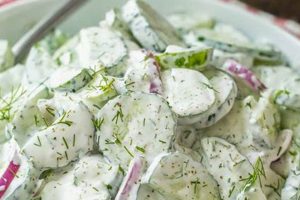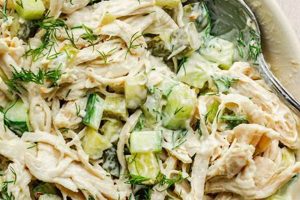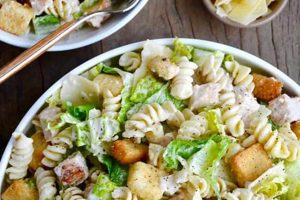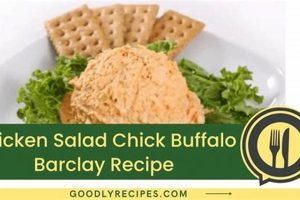A portable and convenient meal option, this dish typically involves romaine lettuce, grilled or roasted chicken, Parmesan cheese, croutons, and Caesar dressing, all wrapped in a large flour tortilla or other suitable flatbread. Variations may include adding other vegetables like tomatoes or cucumbers, or substituting ingredients based on dietary preferences, such as using a vegan Caesar dressing or replacing the chicken with tofu.
This culinary creation offers a refreshing and satisfying meal, perfect for lunch, a quick dinner, or even picnic fare. Its portability makes it an excellent choice for busy individuals or those seeking a less formal dining experience. The combination of crisp lettuce, savory chicken, and creamy dressing provides a balanced flavor profile, while the wrap format keeps the ingredients contained and easy to manage. Historically, the Caesar salad has its origins in Tijuana, Mexico, in the 1920s, while the concept of wrapping foods in flatbreads has ancient roots across various cultures. The fusion of these two concepts has led to a popular contemporary dish.
The following sections will delve deeper into specific aspects of preparing this dish, covering variations, ingredient selection, and step-by-step instructions for achieving optimal results.
Tips for an Exceptional Caesar Salad Wrap
Optimizing ingredient preparation and assembly techniques can significantly elevate this simple dish.
Tip 1: Romaine Selection and Preparation: Opt for crisp, dark green romaine hearts. Thoroughly wash and dry the lettuce to prevent a soggy wrap. Consider chopping the romaine into bite-sized pieces for easier consumption.
Tip 2: Chicken Preparation: Grilled or roasted chicken breast provides optimal flavor and texture. Ensure the chicken is cooked thoroughly and cooled before assembling the wrap. Dicing or shredding the chicken facilitates even distribution within the wrap.
Tip 3: Dressing Application: Instead of directly dressing the romaine, which can lead to sogginess, lightly coat the inside of the tortilla with dressing. This creates a flavorful barrier and prevents the wrap from becoming saturated.
Tip 4: Crouton Considerations: Homemade or high-quality store-bought croutons add a satisfying crunch. For a lighter option, consider omitting croutons or using baked alternatives.
Tip 5: Parmesan Enhancement: Freshly grated Parmesan cheese offers superior flavor compared to pre-grated varieties. Adding the Parmesan directly to the chicken or other ingredients, rather than just sprinkling it on top, can enhance flavor distribution.
Tip 6: Wrap Assembly Technique: Lay the tortilla flat and arrange ingredients evenly across the center. Fold the sides of the tortilla inward, then tightly roll from the bottom up. A slightly warmed tortilla enhances pliability and ease of rolling.
Tip 7: Secure and Serve: If desired, cut the wrap in half diagonally and secure with toothpicks for easier handling. Serve immediately for optimal freshness and flavor.
By following these guidelines, one can create a flavorful and satisfying Caesar salad wrap experience. Attention to detail in ingredient selection, preparation, and assembly techniques ensures a superior final product.
The following section concludes with a summary of key takeaways for creating a truly exceptional Caesar salad wrap.
1. Ingredient Quality
Ingredient quality significantly impacts the overall success of a chicken Caesar salad wrap. The freshness and quality of each component contribute not only to the final flavor profile but also to the texture and overall enjoyment of the dish. Subpar ingredients can result in a bland, soggy, or otherwise unappetizing wrap, while high-quality ingredients elevate the experience. For instance, using fresh, crisp romaine lettuce versus wilted or pre-packaged lettuce creates a noticeable difference in both texture and taste. Similarly, freshly grilled or roasted chicken offers a more robust flavor compared to pre-cooked or processed chicken. The choice of Parmesan cheese also plays a role; freshly grated Parmesan provides a richer, more nuanced flavor than pre-grated alternatives.
The impact of ingredient quality extends beyond individual components to the overall synergy of flavors. High-quality ingredients complement each other, creating a harmonious balance. Freshly made Caesar dressing, utilizing quality olive oil, lemon juice, and garlic, enhances the other flavors rather than masking them. Even seemingly minor components, like the croutons, contribute to the overall texture and flavor. Stale or low-quality croutons can detract from the experience, while crisp, flavorful croutons provide a satisfying crunch. Investing in quality ingredients demonstrates an appreciation for the culinary experience and results in a more satisfying and enjoyable meal.
Ultimately, the pursuit of quality ingredients demonstrates a commitment to crafting a truly exceptional chicken Caesar salad wrap. While convenience may tempt the use of pre-prepared or lower-quality ingredients, the difference in the final product is undeniable. Understanding the impact of ingredient quality empowers informed choices that elevate this seemingly simple dish from ordinary to extraordinary. Recognizing this connection allows for a more deliberate and rewarding culinary experience.
2. Preparation Techniques
Preparation techniques significantly influence the final quality of a chicken Caesar salad wrap. These techniques encompass the handling and processing of each ingredient, impacting texture, flavor, and overall presentation. Consider the chicken: grilling or roasting imparts a smoky char and enhances its inherent savoriness, while boiling can result in a bland, dry outcome. Similarly, the manner in which romaine lettuce is handled affects its crispness and structural integrity. Washing and thoroughly drying the lettuce prevents a soggy wrap, while chopping it into manageable pieces facilitates even distribution and ease of consumption. Even the seemingly simple act of grating Parmesan cheese freshly, rather than using pre-grated, demonstrably elevates the flavor profile.
Specific preparation techniques directly correlate with the desired outcome. For instance, toasting the tortilla imparts a subtle warmth and enhances its pliability, preventing cracking during the rolling process. The way the Caesar dressing is applied also affects the final product. Tossing the romaine lettuce directly in the dressing risks over-saturation and a soggy wrap. Alternatively, lightly coating the inside of the tortilla with the dressing creates a flavorful barrier, preventing the wrap from becoming saturated while still delivering the characteristic Caesar flavor. These seemingly minor details contribute significantly to the overall culinary experience.
Mastery of preparation techniques distinguishes an ordinary chicken Caesar salad wrap from an exceptional one. These techniques are not merely procedural steps but rather integral components of the recipe itself. They represent a conscious effort to optimize the flavor and texture of each ingredient, ultimately contributing to a more satisfying and enjoyable meal. Understanding the nuances of these techniques empowers informed choices, allowing for a more deliberate and rewarding culinary experience. This attention to detail elevates the dish from a simple combination of ingredients to a carefully constructed culinary creation.
3. Flavor Balance
Flavor balance is crucial to a successful chicken Caesar salad wrap recipe. It represents the harmonious interplay of salty, tangy, savory, and creamy elements, creating a cohesive and enjoyable culinary experience. Without proper balance, one element can overwhelm the others, resulting in a less satisfying outcome. Understanding the components of flavor balance and their interactions within this specific dish allows for a more nuanced and deliberate approach to its creation.
- The Tang of Caesar Dressing:
The Caesar dressing provides the foundational tangy element, typically derived from lemon juice, vinegar, or a combination thereof. This acidity cuts through the richness of other ingredients, creating a refreshing counterpoint. Too little tang can result in a bland wrap, while too much can be overpowering. The ideal balance allows the tang to complement, not dominate, the other flavors.
- The Saltiness of Parmesan:
Parmesan cheese contributes saltiness and umami, adding depth and complexity. The quantity and quality of Parmesan influence the overall saltiness of the wrap. Freshly grated Parmesan provides a more nuanced and robust flavor compared to pre-grated alternatives. Balancing the saltiness of the Parmesan with the other ingredients prevents an overly salty or one-dimensional flavor profile.
- The Savory Chicken Element:
The chicken provides the primary savory component. Properly cooked chicken, whether grilled, roasted, or pan-fried, contributes a depth of flavor that complements the other elements. Overcooked or under-seasoned chicken can detract from the overall balance. The quality of the chicken itself also plays a role; free-range or organic chicken often possess a more pronounced and desirable flavor profile.
- The Creamy Texture and Flavor:
The creaminess of the Caesar dressing, often enhanced by egg yolks, mayonnaise, or other emulsifiers, adds a richness and textural contrast. This creaminess balances the crispness of the romaine lettuce and the sharpness of the Parmesan. Overly creamy dressings can lead to a heavy or soggy wrap, while insufficient creaminess can result in a dry or less satisfying experience.
The successful execution of a chicken Caesar salad wrap recipe hinges on the careful orchestration of these flavor components. Each element contributes to the overall balance, and a skilled approach requires understanding their individual roles and interactions. Achieving this balance ensures a harmonious and enjoyable culinary experience, transforming a simple combination of ingredients into a well-rounded and satisfying meal.
4. Wrap Assembly
Wrap assembly is a critical stage in preparing a chicken Caesar salad wrap, directly impacting the final product’s structural integrity, ease of consumption, and overall aesthetic appeal. A well-assembled wrap ensures even ingredient distribution, prevents spillage, and provides a satisfying culinary experience. Conversely, improper assembly can lead to a messy, difficult-to-eat wrap with unevenly distributed flavors. Understanding the key facets of wrap assembly allows for a more methodical and successful approach.
- Tortilla Selection and Preparation:
The choice of tortilla influences both flavor and structural integrity. Large flour tortillas are commonly preferred for their flexibility and ability to hold the ingredients. Warming the tortillas slightly enhances their pliability, reducing the risk of tearing during the rolling process. Alternative options include whole wheat, spinach, or herb-infused tortillas, offering variations in flavor and nutritional content. The size of the tortilla should be proportional to the intended filling volume.
- Ingredient Placement and Distribution:
Strategic placement of ingredients ensures even distribution and prevents structural imbalances. A common technique involves laying the tortilla flat and arranging the romaine lettuce, chicken, Parmesan cheese, and croutons across the center in an elongated oval shape, leaving space at the top and bottom edges. This distribution allows for efficient folding and rolling while ensuring each bite contains a balanced combination of ingredients. Overfilling the wrap can lead to difficulty in rolling and subsequent spillage, while insufficient filling can result in a less satisfying experience.
- Folding and Rolling Technique:
Proper folding and rolling technique creates a secure and aesthetically pleasing wrap. After arranging the ingredients, the bottom edge of the tortilla is folded upwards and over the filling, tucking it in snugly. Then, the sides are folded inwards, creating a sealed edge. Finally, the wrap is tightly rolled upwards from the bottom, maintaining consistent pressure to create a compact cylinder. This technique secures the ingredients and prevents them from falling out during consumption.
- Securing and Serving:
Once rolled, the wrap can be secured with toothpicks or cut in half diagonally for easier handling and serving. Cutting the wrap in half also offers a visual appeal, showcasing the layered ingredients. If not served immediately, wrapping the assembled wraps tightly in parchment paper or plastic wrap helps maintain their freshness and structural integrity. Proper storage prevents the tortillas from drying out and the filling from becoming soggy.
Mastering these facets of wrap assembly transforms the chicken Caesar salad wrap from a simple collection of ingredients into a cohesive and enjoyable culinary creation. Proper assembly ensures not only structural integrity but also enhances the overall eating experience, contributing to a more satisfying and aesthetically pleasing meal. These techniques, though seemingly simple, significantly impact the final product, underscoring the importance of attention to detail in every step of the preparation process. A well-assembled wrap reflects a commitment to culinary excellence and enhances the overall enjoyment of this versatile and popular dish.
5. Portability/Convenience
The portability and convenience of a dish significantly impact its suitability for various occasions and lifestyles. This attribute holds particular relevance for the chicken Caesar salad wrap, contributing to its widespread popularity as a meal option for busy individuals, on-the-go lunches, picnics, and casual dining settings. Examining the facets of portability and convenience within the context of this specific recipe reveals its adaptability and practicality.
- Ease of Transport:
The self-contained nature of the chicken Caesar salad wrap eliminates the need for separate containers and utensils, simplifying transport. Unlike a traditional Caesar salad, which requires a bowl and fork, the wrap format contains all ingredients within a single, portable unit. This characteristic makes it ideal for packed lunches, travel, and outdoor dining, where carrying multiple items can be cumbersome. The structural integrity of a well-assembled wrap also minimizes the risk of spillage during transport, further enhancing its convenience.
- Minimal Preparation Time:
While some preparation is required, a chicken Caesar salad wrap can be assembled relatively quickly, making it a suitable option for time-constrained individuals. Pre-cooked or leftover chicken further streamlines the process. Compared to more elaborate meals, the wrap requires minimal active cooking time. This efficiency contributes to its convenience, especially during busy weekdays or when a quick and satisfying meal is desired.
- Adaptability to Various Settings:
The chicken Caesar salad wrap’s portability lends itself to consumption in a variety of settings, from office desks and park benches to car trips and outdoor events. Its compact form factor eliminates the need for a dedicated dining space, allowing for consumption in informal environments. This adaptability makes it a versatile choice for various occasions, catering to diverse lifestyles and preferences. It functions equally well as a quick lunch, a light dinner, or a convenient snack.
- No-Mess Consumption:
The wrap format contributes to a relatively mess-free dining experience. Unlike a traditional salad, where ingredients can easily spill or require utensils, the wrap contains all components within the tortilla. This self-contained structure minimizes the risk of dripping dressing or scattering croutons, making it a suitable choice for environments where cleanliness is paramount. This characteristic enhances its appeal for on-the-go consumption and situations where formal dining etiquette is not required.
The inherent portability and convenience of the chicken Caesar salad wrap significantly contribute to its popularity and versatility. These characteristics make it an attractive option for individuals seeking a quick, satisfying, and easily transportable meal. By consolidating all the elements of a Caesar salad into a single, convenient package, the wrap format successfully addresses the demands of modern lifestyles, offering a practical and enjoyable dining experience in various contexts. This combination of flavor and practicality solidifies its position as a staple in contemporary cuisine.
Frequently Asked Questions
This section addresses common inquiries regarding the preparation and enjoyment of chicken Caesar salad wraps.
Question 1: Can alternative proteins be used in place of chicken?
Yes, alternatives such as grilled shrimp, tofu, or chickpeas offer suitable substitutes for chicken, catering to dietary preferences and offering varied flavor profiles. Adapting the recipe to incorporate these alternatives requires consideration of complementary flavors and textures.
Question 2: How can sogginess be prevented?
Thoroughly drying the romaine lettuce after washing and lightly coating the inside of the tortilla with Caesar dressing, rather than directly dressing the lettuce, helps prevent sogginess. Consuming the wrap shortly after assembly also minimizes moisture buildup.
Question 3: What are suitable side dishes?
Complementary side dishes include fruit salad, potato chips, coleslaw, or a cup of soup. The choice of side dish often depends on the overall meal context and individual preferences.
Question 4: How can nutritional value be enhanced?
Incorporating whole wheat tortillas, adding more vegetables such as spinach, bell peppers, or cucumbers, and using a lower-fat Caesar dressing can enhance the wrap’s nutritional content. These modifications cater to health-conscious individuals without compromising flavor.
Question 5: Can these wraps be made ahead of time?
While best served immediately, wraps can be assembled a few hours in advance. Storing the assembled wraps tightly in parchment paper or plastic wrap in the refrigerator helps maintain freshness and prevents them from drying out. However, extended storage can increase the risk of sogginess.
Question 6: How can the recipe be adapted for gluten-free diets?
Utilizing gluten-free tortillas or lettuce wraps provides a suitable alternative for those following gluten-free diets. Ensuring all other ingredients, including the Caesar dressing and croutons, are also gluten-free is essential for complete dietary compliance.
Addressing these frequently asked questions provides a comprehensive understanding of preparing and enjoying chicken Caesar salad wraps. Careful consideration of these points ensures a successful and satisfying culinary experience.
The following section offers concluding remarks and summarizes key takeaways for creating exceptional chicken Caesar salad wraps.
Conclusion
Exploration of this culinary creation reveals a dish offering both convenience and customizable flavor profiles. Emphasis on fresh, high-quality ingredients, proper preparation techniques, and balanced flavor combinations contributes significantly to the overall enjoyment. Consideration of wrap assembly methods ensures structural integrity and ease of consumption. The inherent portability of this dish adds to its practicality for various dining occasions.
Achieving culinary excellence requires attention to detail in every step, from ingredient selection to final presentation. This pursuit of quality elevates a simple wrap into a satisfying and flavorful meal. Continued exploration of variations and ingredient combinations offers further potential for culinary innovation.






